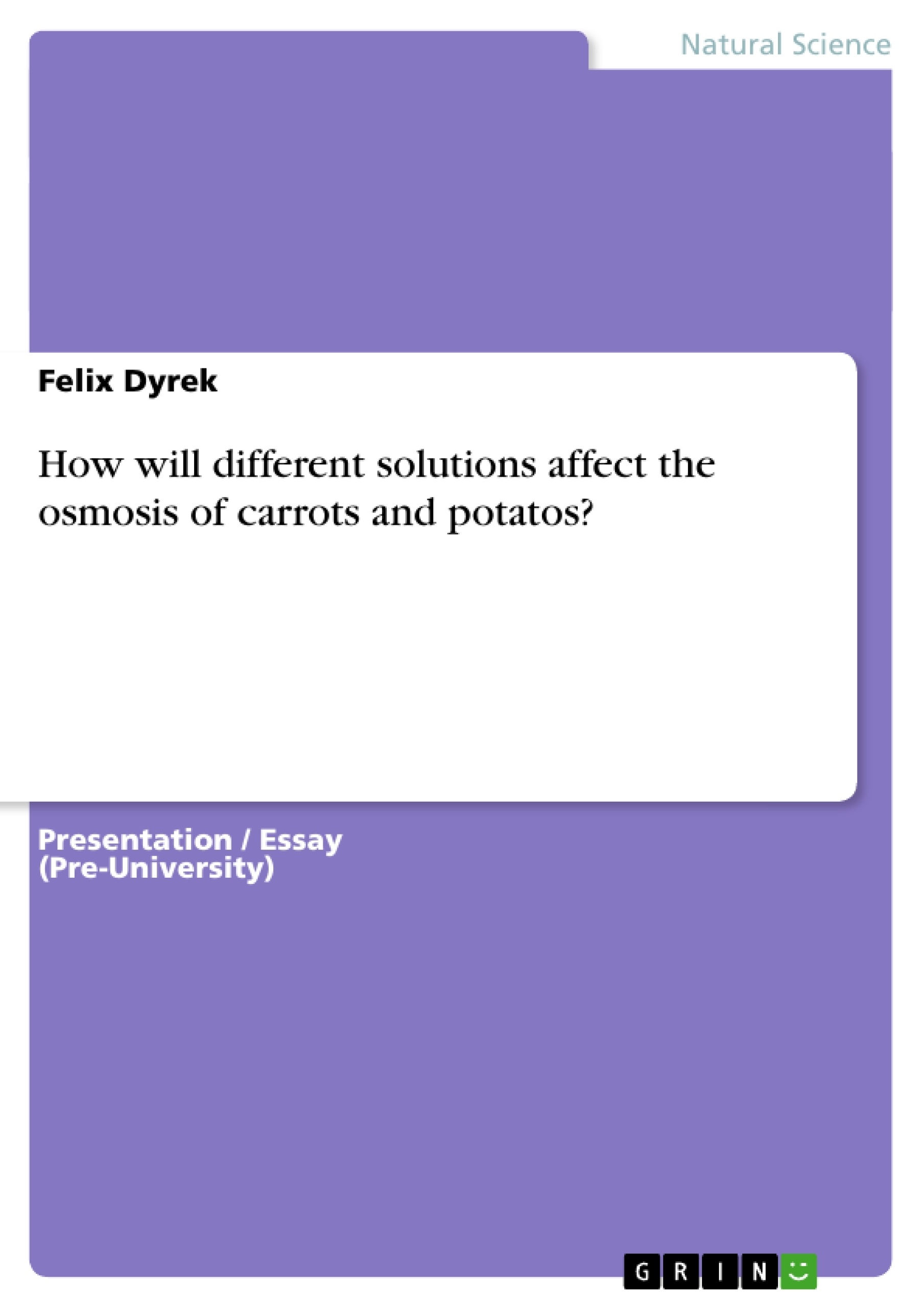The experiment was made in order to check how osmosis occurs in food when its placed in different types of solutions.In my case what was used were carrots and potatos.
Biological Investigation: Osmosis
Introduction:
The experiment was made in order to check how osmosis occurs in food when its placed in different types of solutions.In my case what was used were carrots and potatos.
Research Question:
How will different solutions affect the osmosis of carrots and potatos ?
Hypothesis:
When we put slices of carrots and potatos seperated in two different solutions like destilated
water,vinigar, and water with 10% and 20% salt concentration,the carrots and potatoes will gain water in the destilated water but they will loose it in the concentration of salt and the vingar.The amount of it will stay the same.
Hypothesis Explanation:
The carrots and potatoes will gain water + mass because the concentration of water will have a higer mass than in the cells of the slices.Its a hypotonic solution.In the waters which are salt concentrated the slices will loose water + mass because the salt water is lower concentrated than in the cells of the slices.It is a hypertonic solution.In the vinegar the concentration of water stays more or less the same as the slices so its isotonic solution.
Compounds:
1 small potatoe
1 carrot
400 ml water
100 ml 10% white vinegar
30 gr salt
Variables:
Dependent
solution in which the slices are put in % mass of the slices gr
independent
Apparatus :
4 beakers
4 Petri dishes
1 scale
1 baguette
1 cylinder volume
1 timer
1 knife
1.We cut the potatoe and the carrots in small slices on the cutting board.Then weight out 12 gr of potatoe slices and also 12 gr of carrots slices.In each of the four Petri dishes are 12 gr of potatoe and carrots.
2.The next step is to prepare the solutions in which the carrots and potatoes will be dipped in.For one solution:The graduated cylinder we measure 90 mL of water and poud it into a beaker.Then we add 10 gr salt to it.The next step is to mix it with the baguette until the salt dissolves.The water we have now has a concentration of 10% salt.We repeat the step and use another beaker where we are mixing 80 mL of water with 20 gr salt to recieve a 20% salt conventration.
3.In the first Petri dish we fill 100ml destillated.
In the second Petri dish we fill 100ml of vinegar.
In the third we will 100ml of 10% concentrated salt water .
In the fourth we fill 100ml of the 20% concentrated salt water.
We let the potatoe and the carrot slices for 30 minutes soaking in the soluitons.
4.After 30 minutes we take the carrot and potato slices out of their Petri dishesThen weigh each group, carrots and potatoes separately. Record these measurements, observing if their mass has either increased or decreased.
Frequently Asked Questions
What is the purpose of the biological investigation described?
The experiment aims to investigate how osmosis occurs in food, specifically carrots and potatoes, when placed in different types of solutions.
What is the research question being addressed?
The research question is: "How will different solutions affect the osmosis of carrots and potatoes?"
What is the hypothesis?
The hypothesis is that carrots and potatoes will gain water in distilled water, lose water in salt solutions and stay the same in vinigar.The amount of it will stay the same.
What is the explanation of the hypothesis?
The explanation provides the rationale for the hypothesis, stating that distilled water is hypotonic and hypertonic solutions will cause water to leave the cells, while vinegar will have about the same concentration.
What compounds are used in the experiment?
The compounds used are: 1 small potato, 1 carrot, 400 ml water, 100 ml 10% white vinegar, and 30 gr salt.
What are the variables in the experiment?
The dependent variable is the solution in which the slices are put in (% mass of the slices gr), and the independent variable is being applied.
What apparatus is needed for the experiment?
The required apparatus includes: 4 beakers, 4 Petri dishes, 1 scale, 1 baguette, 1 cylinder volume, 1 timer, and 1 knife.
What are the steps of the experiment?
The experimental procedure involves cutting the potato and carrots into slices, weighing them, preparing different solutions (distilled water, vinegar, 10% salt solution, and 20% salt solution), soaking the slices in these solutions for 30 minutes, and then weighing them again to observe mass changes.
What measurements and observations are to be recorded?
The mass of the carrot and potato slices before and after soaking in the different solutions should be recorded, noting any increase or decrease in mass.
What is the final step after collecting the data?
The final step is to create a chart to display the results and then draw a graph representing the data collected.
- Quote paper
- Felix Dyrek (Author), 2008, How will different solutions affect the osmosis of carrots and potatos?, Munich, GRIN Verlag, https://www.grin.com/document/159585




